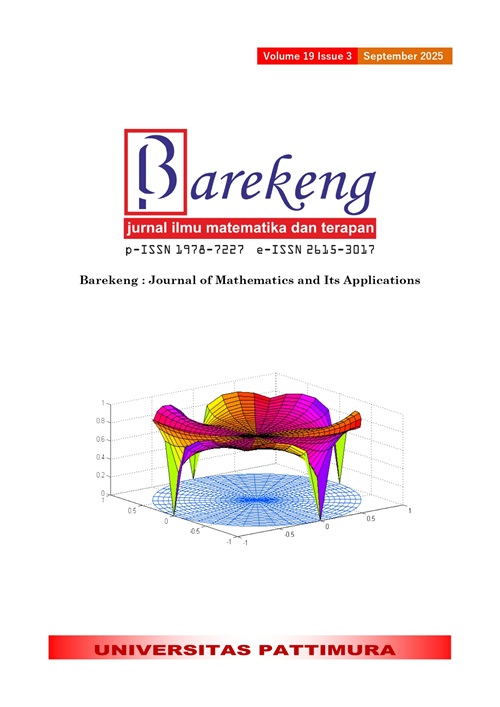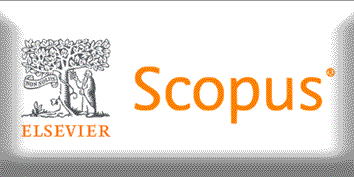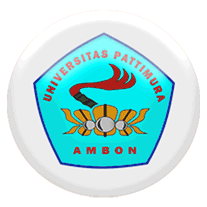MODEL APPROACH OF AGGREGATE RETURN VOLATILITY: GARCH(1,1)-COPULA VS GARCH(1,1)-BIVARIATE NORMAL
Abstract
Aggregate risk is an aggregation of single risks that are both independent and interdependent. In this study, aggregate risk is constructed from two interdependent random risk variables. The dependence between two random variables can be determined through the size of dependence and joint distribution properties. However, not all distributions have joint distribution properties; the joint distributions may be unknown, so motivating the use of the Copulas in this study is needed. Sometimes, the Copula model is introduced to construct joint distribution properties. The Copula model in this research is used in financial policies such as investment. In the investment sector, the aggregate risk comes from the sum of the single risks and returns. The model used in aggregate return is the Generalized Autoregressive Conditionally Heteroscedastic (GARCH) model. The data used in this study is the closing price data for Apple and Microsoft stocks from January 01, 2010, to January 01, 2024. The best model selection is the model with the GARCH-Bivariate Normal approach with the smallest MSE value. Model GARCH(1,1)-Bivariate Normal is the best model for the volatility model of aggregate return.
Downloads
References
A. Afriyeni and D. Marlius, “ANALISIS TINGKAT PENGEMBALIAN DAN RISIKO INVESTASI (STUDI PADA INDUSTRI MANUFAKTUR YANG TERDAFTAR DI BURSA EFEK INDONESIA),” 2019.doi: https://doi.org/10.31219/osf.io/cfb92
D. B. Nugroho, D. Kurniawati, L. Panjaitan, Z. Kholil, B. Susanto, and L. Sasongko, “EMPIRICAL PERFORMANCE OF GARCH, GARCH-M, GJR-GARCH AND LOG-GARCH MODELS FOR RETURNS VOLATILITY,” presented at the Journal of Physics: Conference Series, IOP Publishing, 2019, p. 012003.doi: https://doi.org/10.1088/1742-6596/1307/1/012003
E. M. Kimani, A. Ngunyi, and J. K. Mungatu, “MODELLING DEPENDENCE OF CRYPTOCURRENCIES USING COPULA GARCH,” J. Math. Finance, vol. 13, no. 3, pp. 321–338, 2023.doi: https://doi.org/10.4236/jmf.2023.133020
S. Rastogi and J. Kanoujiya, “IMPACT OF CRYPTOS ON THE INFLATION VOLATILITY IN INDIA: AN APPLICATION OF BIVARIATE BEKK-GARCH MODELS,” J. Econ. Adm. Sci., vol. 40, no. 2, pp. 221–237, 2024.doi: https://doi.org/10.1108/JEAS-08-2021-0167
S. Sharma, V. Aggarwal, and M. P. Yadav, “COMPARISON OF LINEAR AND NON-LINEAR GARCH MODELS FOR FORECASTING VOLATILITY OF SELECT EMERGING COUNTRIES,” J. Adv. Manag. Res., vol. 18, no. 4, pp. 526–547, 2021.doi: https://doi.org/10.1108/JAMR-07-2020-0152
Y. Fang, Y. Fan, M. Haroon, and A. Dilanchiev, “EXPLORING THE RELATIONSHIP BETWEEN GLOBAL ECONOMIC POLICY AND VOLATILITY OF CRUDE FUTURES: A TWO-FACTOR GARCH-MIDAS ANALYSIS,” Resour. Policy, vol. 85, p. 103766, 2023.doi: https://doi.org/10.1016/j.resourpol.2023.103766
L. Deng, C. Ma, and W. Yang, “PORTFOLIO OPTIMIZATION VIA PAIR COPULA-GARCH-EVT-CVAR MODEL,” Syst. Eng. Procedia, vol. 2, pp. 171–181, 2011.doi: https://doi.org/10.1016/j.sepro.2011.10.020
X. Sun, C. Liu, J. Wang, and J. Li, “ASSESSING THE EXTREME RISK SPILLOVERS OF INTERNATIONAL COMMODITIES ON MARITIME MARKETS: A GARCH-COPULA-COVAR APPROACH,” Int. Rev. Financ. Anal., vol. 68, p. 101453, 2020.doi: https://doi.org/10.1016/j.irfa.2020.101453
R. Ab Razak and N. Ismail, “DEPENDENCE MODELING AND PORTFOLIO RISK ESTIMATION USING GARCH-COPULA APPROACH,” Sains Malays., vol. 48, no. 7, pp. 1547–1555, 2019.doi: https://doi.org/10.17576/jsm-2019-4807-24
X. W. Yeap, H. H. Lean, M. G. Sampid, and H. Mohamad Hasim, “THE DEPENDENCE STRUCTURE AND PORTFOLIO RISK OF MALAYSIA’S FOREIGN EXCHANGE RATES: THE BAYESIAN GARCH–EVT–COPULA MODEL,” Int. J. Emerg. Mark., vol. 16, no. 5, pp. 952–974, 2021.doi: https://doi.org/10.1108/IJOEM-02-2020-0169
B. Rašiová and P. Árendáš, “COPULA APPROACH TO MARKET VOLATILITY AND TECHNOLOGY STOCKS DEPENDENCE,” Finance Res. Lett., vol. 52, p. 103553, 2023.doi: https://doi.org/10.1016/j.frl.2022.103553
J. Salma, “CRUDE OIL PRICE UNCERTAINTY AND STOCK MARKETS IN GULF CORPORATION COUNTRIES: A VAR-GARCH COPULA MODEL,” Glob. J. Manag. Bus. Res., vol. 15, no. 10, pp. 29–38, 2015.
N. T. Hung, “CONDITIONAL DEPENDENCE BETWEEN OIL PRICES AND CEE STOCK MARKETS: A COPULA-GARCH APPROACH,” East. J. Eur. Stud., vol. 11, no. 1, pp. 62–86, 2020.
S. E. Saleh, D. Pakaya, I. K. Hasan, and I. Djakaria, “APPLICATION OF THE COPULA METHOD TO ANALYZE THE RELATIONSHIPS OF MACROECONOMIC FACTORS AFFECTING THE CSPI,” BAREKENG J. Ilmu Mat. Dan Terap., vol. 17, no. 2, pp. 0903–0912, 2023.doi: https://doi.org/10.30598/barekengvol17iss2pp0903-0912
T. Ardhitha, E. Sulistianingsih, and N. Satyahadewi, “VALUE AT RISK ANALYSIS ON BLUE CHIP STOCKS PORTFOLIO WITH GAUSSIAN COPULA,” BAREKENG J. Ilmu Mat. Dan Terap., vol. 17, no. 3, pp. 1739–1748, 2023.doi: https://doi.org/10.30598/barekengvol17iss3pp1739-1748
R. B. Nelsen, “COPULAS AND QUASI-COPULAS: AN INTRODUCTION TO THEIR PROPERTIES AND APPLICATIONS,” in Logical, algebraic, analytic and probabilistic aspects of triangular norms, Elsevier, 2005, pp. 391–413.doi: https://doi.org/10.1016/B978-044451814-9/50014-8
S. Rahmah, R. Budiarti, and I. G. P. Purnaba, “ANALYSIS OF THE DEPENDENCIES COMMODITY PRICES AND STOCK MARKET INDEXES,” BAREKENG J. Ilmu Mat. Dan Terap., vol. 18, no. 3, pp. 1563–1572, 2024.doi: https://doi.org/10.30598/barekengvol18iss3pp1563-1572
J. S. Seleky, “KAJIAN SIFAT EKOR TEBAL DISTRIBUSI MODE-CENTERED BURR,” AKSIOMA J. Mat. Dan Pendidik. Mat., vol. 13, no. 3, pp. 436–447, 2022.doi: https://doi.org/10.26877/aks.v13i3.14170
B. Rikumahu, “PEMODELAN DISTRIBUSI TINGKAT IMBAL HASIL INDEKS HARGA DI TUJUH BURSA ASIA,” J. Manaj. Indones., vol. 14, no. 1, pp. 1–15, 2014.doi: https://doi.org/10.25124/jmi.v14i1.348
J. Devitra, “KINERJA KEUANGAN DAN EFISIENSI TERHADAP RETURN SAHAM PERBANKAN DI BURSA EFEK INDONESIA PERIODE 2007-2011,” J. Keuang. Dan Perbank., vol. 15, no. 1, 2013.
Copyright (c) 2025 Asysta Amalia Pasaribu, Anang Kurnia

This work is licensed under a Creative Commons Attribution-ShareAlike 4.0 International License.
Authors who publish with this Journal agree to the following terms:
- Author retain copyright and grant the journal right of first publication with the work simultaneously licensed under a creative commons attribution license that allow others to share the work within an acknowledgement of the work’s authorship and initial publication of this journal.
- Authors are able to enter into separate, additional contractual arrangement for the non-exclusive distribution of the journal’s published version of the work (e.g. acknowledgement of its initial publication in this journal).
- Authors are permitted and encouraged to post their work online (e.g. in institutional repositories or on their websites) prior to and during the submission process, as it can lead to productive exchanges, as well as earlier and greater citation of published works.






1.gif)



